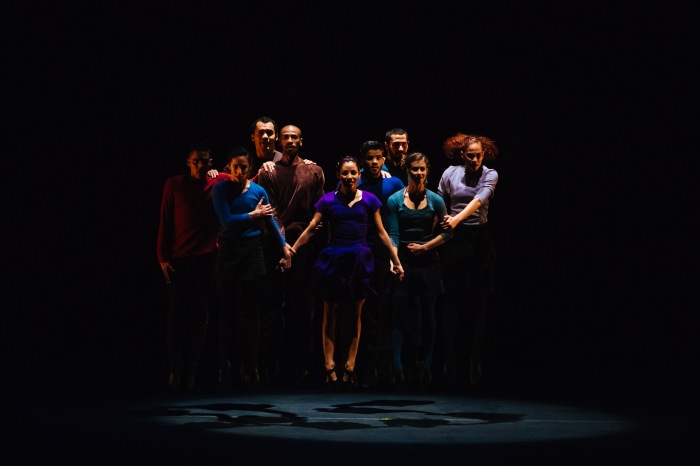Beautiful, connected, skilled dancing from Cuba—a luscious blend of ballet, modern, release-technique, partnering, and street dancing, providing a movement vocabulary that can say just about anything. The Music Center’s celebration of Cuban arts as one of three parts of the Getty’s Far-Reaching Arts Program presents Malpaso Dance Company (Malpaso) in its Los Angeles debut. Malpaso, a Cuban dance company, and an associate dance company of The Joyce Theater Productions, founded in 2012 by Osnel Delgado (company director and resident choreographer), Fernando Sáez (executive director), and Daileidys Carrazana (dancer), performed three dance works at the Music Center’s Dorothy Chandler Pavilion on December 2, 2017. The bill included a modern work by Delgado, a contemporary jazz work by Sonya Tayeh, and a contemporary-modern work by Aszure Barton. I experienced the 2:00 p.m. matinee performance.

Live music introduced and accompanied the opening dance work, 24 Hours and a Dog (2013), choreographed by Osnel Delgado. The jazz music by Arturo O’Farill, Aberlardo Valdes, and Astor Piazzolla filled the hall and supported the well-crafted choreography and polished dancing. The Afro Latin Jazz Ensemble musicians Arturo O’Farrill, Vincent Cherico, Carlo De Rosa, Seneca Black, Keisel Jimenez-Leyva, Carlos Maldonado, Rafi Malkiel, and Ivan Renta performed with a delightful, spirited resonance. While the music was rooted in rhythm throughout the 33-minute dance, curiously, the dance started out rather ignoring the rhythmic component of the music. Instead, line, shape, and design of bodies was the focus at first, and rhythm began to emerge as the piece evolved through the seven sections of the dance that represent the 24 hours of one’s very busy day. Soloist and choreographer, Osnel Delgado, with his long legs, supple body, and smooth movements, changed shape with a smooth, controlled flow while changing from middle to high to low levels. Four more male dancers entered and created relationships between partners, each showcasing connected relationships with each other, creating patterns and designs in space. Four female dancers enter and dancers take a stance of “readiness,” with a searching gaze that goes quite a distance. Dancers reveal strong connections to each other by intertwining in complex relationships. The piece gradually explores the rhythm of the jazz music more and more, which was satisfying. The piece ended with eight of the dancers succumbing to gravity at the end of their day with feet facing the audience, a position Delgado revealed earlier in the dance, but this time Delgado ends in a crouch with hands held in front of his face, seemingly exhausted at the end of a rough day. The piece is well crafted, whimsical, and showcases the virtuosity of the company well. Dancers in this piece were Dunia Acosta, Esteban Aguilar, Maria Karla Araujo, Fernando Benet, Daileidys Carrazana, Osnel Delgado, Manuel Durán, Beatriz Garcia, and Abel Rojo.

Malpaso premiered Face the Torrent, a dance representing a mesmerized struggle choreographed by contemporary jazz choreographer Sonya Tayeh and commissioned by The Music Center and the Getty-led initiative Pacfic Standard Time: LA/LA. Tayeh was assisted by Austin Goodwin and Chelsea Thedinga. The pace was hypnotic at first, as a line of dancers gradually walked side-by-side toward the audience swaying to and fro with each step. One man gestures in anguish and shudders while the others ignore him. Finally, a woman reaches toward him offering assistance. They relate to each other, pairing their struggle as one. She eventually releases him and rejoins the group. The man shudders and shakes again, eventually rolling upstage alone. The others are affected by something they hear, and two more dancers start leaving the slow motion wave-like walk. The dancers become increasingly sinewy, powerful, and alive in relation to each other. The value is placed equally on emotions and the movement. The man shudders again. The hypnotic walking begins again interspersed with floor work, women traveling slowly together with bent postures, flexed arms, and outstretched fingers, all but one leaving the stage. The men lift the last woman, carry her, and toss her. She looks sad, heavy, and forlorn. Whispering voices in the music begin to fill the space. There is a mood of struggle, sadness, and fear. The hypnotic people in the line walk away from the audience, swaying to and fro. A shudder or pulse occurs in the bodies. On a final downbeat in the music, the dancers twist to cast an intense gaze at the audience. Dancers performing in this piece were Dunia Acosta, Esteban Aguilar, Maria Karla Araujo, Fernando Benet, Daileidys Carrazana, Manuel Durán, Beatriz Garcia, Abel Rojo. Music was by Seed/Stem/Calyx, by Colette Alexander with the Bengsons.

The third piece, Indomitable Waltz (2016), choreographed by Aszure Barton, and assisted by Emanuell Alsberry, delights in its effortless use of body connectivity patterns and weaving relationships between dancers. Dancers flow, touch, lift, tilt, lean, support, and undulate using a plethora of interesting relationships that reveal care, sensitivity, play, curiosity, and sharing among a community that exists in the meter of ¾ time. While the movement phrases are crafted with great care, and the dancing is splendid, the disparate music selections seem not to have been well joined to create a whole. The music shifts abruptly in timbre and mood between the six pieces of music, and the dancers are left to mend the conspicuous breaks with movement segues. The music selections were three pieces by Alexander Balanescu, Waltz, The Young Conscript and the Moon, and Love Scene; one piece by Michael Nyman, String Quartet No. 2: II; and two pieces by Nils Frahm, Circling and 04:33. Despite the abrupt music editing, this piece is a delight to watch, due to the well-rehearsed and talented dancers: Dunia Acosta, Esteban Aguilar, Maria Karla Araujo, Fernando Benet, Daileidys Carrazana, Osnel Delgado, Manuel Durán, and Lisbeth Saad.